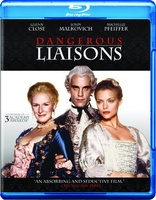Dangerous Liaisons Blu-ray Movie
HomeDangerous Liaisons Blu-ray Movie 
Warner Bros. | 1988 | 120 min | Rated R | Feb 07, 2012Movie rating
7.4 | / 10 |
Blu-ray rating
| Users | 0.0 | |
| Reviewer | 4.5 | |
| Overall | 4.5 |
Overview
Dangerous Liaisons (1988)
It is pre-Revolution France. The Marquise de Merteuil (Glenn Close) and the Vicomte de Valmot (John Malkovich) are decadent members of the Paris aristocracy. The Marquise challenges the Vicomte to conquer young Cecile (Uma Thurman), the wife-to-be of an old friend. However, the perverse Vicomte prefers to work upon the seduction of Madame de Tourvel (Michelle Pfeiffer), a married and moral young aquaintance. The sexual and social repercussions of the seduction has disastrous effects.
Starring: Glenn Close, John Malkovich, Michelle Pfeiffer, Swoosie Kurtz, Keanu ReevesDirector: Stephen Frears
| Romance | Uncertain |
| Drama | Uncertain |
| Melodrama | Uncertain |
| Period | Uncertain |
| Erotic | Uncertain |
Specifications
Video
Video codec: MPEG-4 AVC
Video resolution: 1080p
Aspect ratio: 1.78:1
Original aspect ratio: 1.85:1
Audio
English: DTS-HD Master Audio 5.1
French: Dolby Digital 2.0
Spanish: Dolby Digital 2.0
German: Dolby Digital 2.0
Italian: Dolby Digital 2.0
Portuguese: Dolby Digital 2.0
also Spanish (Castilian): Dolby Digital 2.0
Subtitles
English SDH, French, German SDH, Italian SDH, Portuguese, Spanish, Danish, Dutch, Finnish, Norwegian, Swedish
Discs
50GB Blu-ray Disc
Single disc (1 BD)
Playback
Region free
Review
Rating summary
| Movie | 5.0 | |
| Video | 4.0 | |
| Audio | 3.5 | |
| Extras | 3.0 | |
| Overall | 4.5 |
Dangerous Liaisons Blu-ray Movie Review
What's Love Got to Do With It?
Reviewed by Michael Reuben February 4, 2012Timing is everything. When French army officer Pierre Choderlos de Laclos published the book Les Liaisons dangereuses in 1782, it was considered trash. Only later was it elevated into one of the great works of Western literature, one of the most famous in a new form: a novel told exclusively in letters (the so-called "epistolary novel"), with the occasional wry observation by the "editor" of the compilation. Today, though, Laclos has few readers outside the academy. One of them was future playwright and filmmaker Christopher Hampton, who fell in love with the story as a student and thought it would make a great drama. No one in the British theater community shared Hampton's vision, but eventually he was able to get his inventive dramatization mounted in a tiny theater in the London equivalent of off-Broadway, where it was an immediate hit. It eventually transferred to the mainstream West End, where it ran for years, both in London and on Broadway. Among other things, the play launched the career of a previously unknown actor named Alan Rickman, who put his indelible stamp on the French philanderer Valmont long before the world came to know him as Hogwarts' Professor Snape. (Rickman didn't get to recreate his role in the film, but that same year he was everywhere on American movie screens as Hans Gruber in Die Hard.) Director Stephen Frears (The Queen) never saw Hampton's stage play and has said that, if he had, he'd have been too intimidated to make the movie. Having never read Laclos' novel either, Frears came to the project with no preconceptions, and his cinematic imagination was unencumbered. Hampton had already transformed the novel, inventing scene after scene that Laclos had never envisioned. In Laclos' world, his two main characters—the duplicitous Marquise de Merteuil and the serial seducer Valmont—corresponded but never met in person. Hampton repeatedly put them in the same room, where they schemed, traded confidences, battled and ultimately destroyed each other. Frears, who had never before done a period piece (or, as he called it, a movie "in frocks"), added the elaborate decor, costumes and environment that bred mentalities like that of Valmont and the Marquise, and he used well-chosen close-ups and suggestive blocking and framing to reveal layers and nuances of character that reward multiple viewings. The result was nominated for seven Oscars, including best picture, and won three, including for Hampton's script. Also, in a rare example of cross-cultural generosity, the French film industry honored Dangerous Liaisons with a César award for "Best Foreign Film", even though an English writer and director and a group of mostly American actors had dared to tinker with one of the country's national treasures.
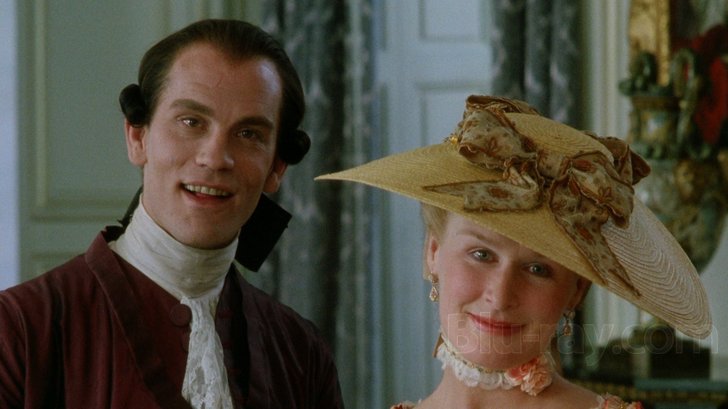
"I thought betrayal was your favorite word." "No, no. Cruelty. I always think that has a nobler ring to it."
Laclos never identified the year in which Dangerous Liaisons is set, and neither does the film, but it opens with a sequence that tells you everything you need to know about the era, the social structure and the two main characters. It's a wordless piece of pure cinema created by Frears, Hampton and costume designer James Acheson (another of the film's Oscar winners) after production was underway, and it simply shows the Marquise de Merteuil (Glenn Close) and the Vicomte de Valmont (John Malkovich) rising and dressing, each in their separate home. But what a project for each of them! As hours pass and servants surround them, fussing, powdering, buckling, pinning, stitching, it becomes clear that this is a pre-industrial age where nothing is easy, unless you have the money and social position to have people do everything for you—and even then, it takes forever. What's a clever mind to do with all that downtime? Nothing good, in the case of the Marquise and Valmont. When they are finally ready to face the world, Valmont sallies forth in response to a summons from the Marquise. Former lovers and now confidantes in romantic mischief, the Marquise and Valmont amuse each other with tales of their adventures, but today she has a task for him. Her current lover, one Bastide, has dropped her in favor of an engagement to a virgin fresh out of convent school, young Cécile de Volanges (Uma Thurman, who was seventeen when she made the film). Cécile happens to be the daughter of the Marquise's cousin, Madame de Volanges (Swoosie Kurtz), which makes it easy for the Marquise to arrange an introduction. She wants Valmont to seduce Cécile and ruin her chastity, so that Bastide discovers on his wedding night that he's already a cuckold. But Valmont declines the Marquise's request, because it's too easy. A seducer of his experience craves tougher challenges, and Valmont has set his sights on one Madame de Tourvel (Michelle Pfeiffer), a beautiful married woman renowned for her religious devotion, strict morals and fidelity to her husband, who is conveniently away on business for the summer. Meanwhile, Madame de Tourvel is staying in the country with Valmont's aunt, Madame de Rosemonde (Mildred Natwick, in her last film). Off to the country goes Valmont, accompanied by his loyal valet, Azolan (Peter Capaldi), who has become an expert at assisting his master's exploits, including seducing the maids of Valmont's targets to obtain their cooperation. As a poor substitute for Valmont, the Marquise turns to a young music teacher, the Chevalier Danceny (Keanu Reeves, low-key and effective), whom she persuades Cécile's mother to engage. He falls in love with the pretty girl easily enough, but he's useless at getting her into bed. Fortunately for the Marquise, Valmont's interest is renewed when he discovers that Madame de Tourvel has been forewarned against him by Cécile's mother. Now he has his own personal score to settle with the Volanges family, and he turns with alacrity to engineering poor Cécile's downfall, which, as Valmont predicted, takes almost no time at all. Madame de Tourvel's surrender takes longer, but Valmont is passionate, relentless and impossible to resist. It's what happens after he succeeds that surprises everyone, including Valmont. The cast is uniformly excellent, but the leads are stunning, giving performances of such complexity that one can watch the film many times (and I have) and still catch new details of gesture and expression. Both Close and Pfeiffer were nominated for Oscars. In Pfeiffer's case, it's the emotional transparency, which creates the often unnerving effect of seeing right through Madame de Tourvel's gorgeous skin directly into her increasingly troubled soul. In Close's case, it's the opposite effect, because the Marquise is, in her own phrase, a "virtuoso of deceit". Her face is a carefully arranged mask, which Close can reshape in an instant. Only in moments when the Marquise is unobserved (except, of course, by the camera) does her face betray an occasional flash of true feeling, and then Close shows you how quickly the Marquise strangles it. Still, as Frears observes on the disc's commentary, it's Malkovich as Valmont who does much of the film's "heavy lifting". In Malkovich's interpretation, Valmont is always "on", always watching himself play a part for others, always enjoying the way a turn of phrase or an exaggeration of gesture draws a little more attention his way. When Madame de Volanges says of Valmont that "he never opens his mouth without first calculating what damage he can do", she is correct up to a point. What Malkovich supplies is the why, the sheer pleasure Valmont takes in being known for causing damage. And then he shows you the shock of recognition when Valmont discovers too late that this time he's the one who's been harmed.
Dangerous Liaisons Blu-ray Movie, Video Quality 
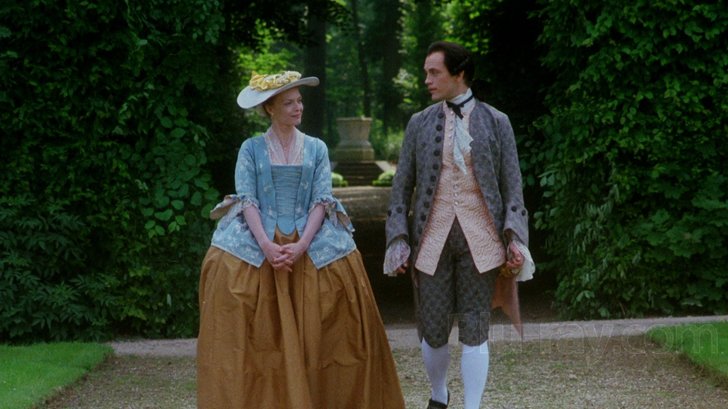
As Frears and Hampton note in their commentary, the photographic style for much of Dangerous Liaisons was borrowed from two previous period films, Fellini's Casanova and Barry Lyndon, where the brightest light source in the frame for key scenes is a candle. This challenging approach can yield a detailed image in the hands of a talented cinematographer like the Oscar-winning Philippe Rousselot (A River Runs Through It), but there's no way to avoid seeing the grain. Warner's 1080p, AVC-encoded Blu-ray retains both the detail and the grain, but viewers expecting that Blu-ray treatment will instantly convert this stylized period piece into a glossy Downton Abbey-like production will be disappointed. This was an analog creation from the photochemical world, and that's what the Blu-ray supplies. That the Blu-ray's reproduction of fine detail is impressive becomes evident as soon as one begins to study the patterns of fabrics and lace in James Acheson's Oscar-winning costumes, or the details in the furniture and decor in the Oscar-winning production design by Stuart Craig and Gérard James. That the muted colors and variable shadows of the many night interiors are accurately reproduced can be verified by reference to the late sequence depicting an outdoor duel in the snow near dawn, which could almost be in black-and-white and demonstrates that the transfer is capable of depicting both accurately. Daytime scenes, especially in the countryside, where natural light is more abundant, provide an array of subtly varying and distinctive colors. The grain patterns appear natural and undisturbed by digital manipulation. Indeed, there were moments, especially in wide shots, when it appeared to my eye that the grain might have picked up some additional video noise on its route from the analog to the digital realm. It seems, however, that Warner is so firmly against the use of DNR that it would rather leave in the noise than risk taking out the grain. I did not encounter any of the typical artifacts that result from artificial sharpening, nor were there any compression artifacts. (Additional note: A poster on another board who received an early copy of this title reported major distortion commencing with chapter 6 (when Valmont visits the peasant home) and spoke ominously of a "botched job". I have now played the review copy on three different setups (a Panasonic BD-50, a PS3 and a BD-ROM drive) and have seen no such problem.)
Dangerous Liaisons Blu-ray Movie, Audio Quality 
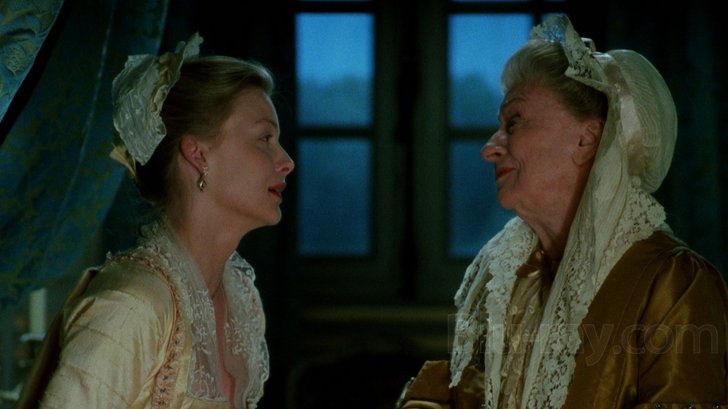
Dangerous Liaisons was released to theaters in stereo. The original track was remixed for 5.1 for the film's 1997 DVD, and the Blu-ray appears to contain the same track in a lossless DTS-HD MA presentation. The remix is conservative, keeping the voices and effects in the front and using the discrete format to expand the space in which George Fenton's score accentuates the drama (with assistance from Bach, Handel and Vivaldi). The orchestral arrangements sound perfectly fine in this presentation, but they don't have quite the sweep or the dynamic range that one might expect from a contemporary recording. The bass extension isn't as deep, the top end is a bit thin, and the mid-range isn't as full and well-rounded as in the best reproductions, but these are minor quibbles. The dialogue is certainly clear, a result not only of the recording but of the quality of the actors' delivery; they're playing articulate characters who speak in a stylized but contemporary idiom, and it's a point of pride to make their words understood, because those words are an essential part of their deceptive games.
Dangerous Liaisons Blu-ray Movie, Special Features and Extras 
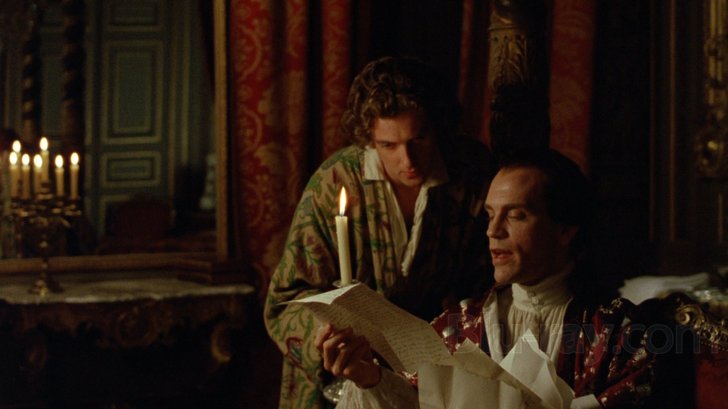
- Commentary with Director Stephen Frears and Writer Christopher Hampton: This commentary has not appeared on any prior release of Dangerous Liaisons in region 1 or region A with which I'm familiar. Internal references indicate that it was recorded sometime after 2003, because the speakers refer to the Korean adaptation of Laclos' novel, The Scandal. Neither Frears nor Hampton had seen the film for a long time, and there are numerous pauses during which they become absorbed in viewing. When they do speak, however, the comments are valuable. Hampton is informative about the history of the project, and Frears offers useful perspective on filming challenges. Of particular interest is their frequent exchanges over the many differences between the film and the stage play, some of which were made by Hampton and some of which resulted from cast changes. (For example, Malkovich and Rickman took radically different approaches to the critical scene in which Valmont breaks with Madame de Tourvel.)
- Theatrical Trailer (SD; 1.33:1; 1:32): If you don't already know the film, the trailer's musical accompaniment and editing rhythm make it look like a rollicking comedy. There's comedy in it, but it's a serious film.
Dangerous Liaisons Blu-ray Movie, Overall Score and Recommendation 

One indicator of the success of Dangerous Liaisons at perfecting Hampton's dramatization of the novel is the degree to which the film has overshadowed the play that spawned it. A Broadway revival in 2008 with a first-rate cast felt wan and bloodless compared to the emotional depth and nuance that Frears captured from the film's cast and in the absence of the story additions that the film medium allowed. Examples of less-than-successful translations from stage to screen abound, but in this instance the stage version now appears to have been a resting point en route to the full-fledged and definitive version that is Frears's film, which is now, at long last, available on Blu-ray. Highly recommended.
Similar titles
Similar titles you might also like

Closer
2004

Bel Ami
2012

Madame Bovary
2014

The Beguiled
2017

By the Sea
2015

Othello
1995

Valmont
1989

The Other Boleyn Girl
2008

Labor Day
2013

Fifty Shades Freed
Unrated Edition
2018

Love & Friendship
2016

The Duchess
2008

Fifty Shades of Grey
Unrated Edition
2015

The Best of Everything
Limited Edition to 3000
1959

Far from the Madding Crowd
2015

Laurence Anyways
2012

Ophelia
2018

The Hunchback of Notre Dame
1939

Wuthering Heights
1939

Moll Flanders
1996
